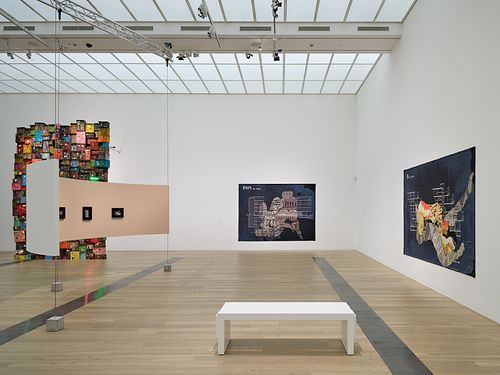AUDIO
Shannon Bool
The Canadian artist Shannon Bool, who lives in Berlin, has long been fascinated by the technique of weaving and enjoys working with it.
The artist cleverly addresses tapestry’s ability to weave several layers together in such a way that a story emerges at the end, as you can see in her works selected for this exhibition. Take a look at the two large-format tapestries. Can you see an architectural blueprint in the background of each? These plans were designed by the Swiss-French architect Le Corbusier, whose work Shannon Bool admires, though she also views it with a critical eye.
They show luxury apartments designed by Le Corbusier in the 1930s for the city of Algiers, which at the time was under French colonial rule. The dwellings were conceived with the European middle class in mind. Back then, Le Corbusier prepared these plans for modernizing and reconfiguring the city of his own accord. He called the project Obus, which means “grenade” or “bomb” in French.
The colorful, amorphous figures hovering over the architectural designs are women’s bodies. They, too, hark back to Le Corbusier. It is said—and Le Corbusier’s sketchbooks confirm this—that the architect visited brothels during his time in Algiers and made erotic drawings there. Shannon Bool has placed Le Corbusier’s depictions of women over his architectural plans; she then enlarged them and filled the drawings with patterns from North African rugs. In turn, Bool’s female bodies, with their voluminous forms, overlay and dominate Le Corbusier’s designs.
We are also showing five works from the series Bombshell in the exhibition. Here, Shannon Bool superimposes vintage black-and-white postcards of nude North African women with certain details from Le Corbusier’s designs, and also from his model for the Obus plan. But this time, the architecture merges with the figures, appearing like their continuation or even seeming to forcibly thrust into the female bodies. Such postcards as those used by Bool here were very popular in Europe starting in the late nineteenth century; they catered to the fantasies of colonial rulers.
Shannon Bool presents to us this appropriation of the female body—both in Le Corbusier’s sketches and in the postcards—as a metaphorical conquering, as it were, of the city of Algiers and its architecture.
The artist cleverly addresses tapestry’s ability to weave several layers together in such a way that a story emerges at the end, as you can see in her works selected for this exhibition. Take a look at the two large-format tapestries. Can you see an architectural blueprint in the background of each? These plans were designed by the Swiss-French architect Le Corbusier, whose work Shannon Bool admires, though she also views it with a critical eye.
They show luxury apartments designed by Le Corbusier in the 1930s for the city of Algiers, which at the time was under French colonial rule. The dwellings were conceived with the European middle class in mind. Back then, Le Corbusier prepared these plans for modernizing and reconfiguring the city of his own accord. He called the project Obus, which means “grenade” or “bomb” in French.
The colorful, amorphous figures hovering over the architectural designs are women’s bodies. They, too, hark back to Le Corbusier. It is said—and Le Corbusier’s sketchbooks confirm this—that the architect visited brothels during his time in Algiers and made erotic drawings there. Shannon Bool has placed Le Corbusier’s depictions of women over his architectural plans; she then enlarged them and filled the drawings with patterns from North African rugs. In turn, Bool’s female bodies, with their voluminous forms, overlay and dominate Le Corbusier’s designs.
We are also showing five works from the series Bombshell in the exhibition. Here, Shannon Bool superimposes vintage black-and-white postcards of nude North African women with certain details from Le Corbusier’s designs, and also from his model for the Obus plan. But this time, the architecture merges with the figures, appearing like their continuation or even seeming to forcibly thrust into the female bodies. Such postcards as those used by Bool here were very popular in Europe starting in the late nineteenth century; they catered to the fantasies of colonial rulers.
Shannon Bool presents to us this appropriation of the female body—both in Le Corbusier’s sketches and in the postcards—as a metaphorical conquering, as it were, of the city of Algiers and its architecture.
